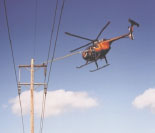Asubstantial percentage of North America’s overhead transmission lines are supported by wooden poles and crossarms. Degradation and failure of these poles and arms are major threats to the reliability of electric power transmission systems. The diminished wood strength caused by rot and decay is often difficult or impossible to detect by visual inspections, even when viewed at close range.
Today’s most commonly used practice for assessing the in-service condition of wooden poles and arms hasn’t changed for over a century! Linemen are still sent on costly and slow climbing inspections, where they “sound” the poles and crossarms, by tapping with a hammer and listening for the tell-tale sound of a hollow spot in the wood. This method is not very reliable because it usually fails to reveal weak areas in the wood, unless they are quite close to the area being sounded.
What’s more , because climbing inspections are inherently very labor intensive and time consuming, transmission structures are typically subjected to this process no more often than once every five years. Intervals of ten years or greater are not uncommon. Unfortunately, wooden crossarms that had appeared to be in perfect condition can deteriorate to a severely weakened state in only one or two years. Undetected internal degradation of the wood can result in weakening to the point where complete failure can occur.
The cost of replacing a weakened crossarm arm can range from $2,000 to upwards of $4,000 or more, depending on the accessibility of the structure. Line outages resulting from completely failed crossarms can have significant and costly consequences.
For these reasons, transmission line managers have often wished for an affordable inspection method that would enable them to reliably assess the structural integrity of the arms and poles of wooden structures – before they fail catastrophically and without warning.
With that quest in mind, Entergy Transmission, of New Orleans, Louisiana, commissioned the National Electric Energy Testing Research and Applications Center, better known by its acronym, NEETRAC, to find or develop such a system. NEETRAC is a research center of Georgia Tech – The Georgia Institute of Technology.
Entergy’s Technology Support Group gave NEETRAC carte blanche on the choice of technology to address this need, so long as the technology would be economical enough to use cost effectively at frequent intervals, preferably annually.
NEETRAC considered a wide range of intriguing possibilities. After careful evaluation, they selected the combination of two technologies – laser vibrometry and artificial neural networks. To this unusual mix, the NEETRAC engineers added a third component – helicopters – to make their system “fly” – literally and figuratively. The resulting invention was named AVIANNTM, an acronym for Airborne Vibrometry Inspection Analyzed By Neural Network.
Laser vibrometry?
Neural networks?
Helicopters?
How does it all work?
AVIANNTM uses a helicopter equipped with a laser doppler vibrometer to record the vibration that is induced in each structure’s arms and poles by the sound of the helicopter as it hovers nearby. The sound produced by a hovering helicopter “excites” the target object, such as a crossarm or pole. The laser vibrometer uses doppler shift technology to read the vibration spectrum of the target objects. The distinctive vibration signatures of each arm or pole are digitized and recorded as data files, and matched with the global positioning system (GPS) coordinates of the structure being examined.
However, obtaining the vibration signatures is just the beginning of the process, because the correlation that exists between each object’s vibration spectrum and its structural integrity is not visually discernible. In a post-processing step, the vibration files are analyzed by AVIANN’s neural network software, which uses complex algorithms to produce a predicted breaking strength value for each object tested.
An important accomplishment in the initial development of this technology was the “training” of the artificial neural network (the “ANN” in AVIANN™). Artificial neural networks are a form of artificial intelligence, so named because their algorithms mimic the neurons of the human brain. Since wood crossarm inspections were Entergy’s prime objective for the research that led to the development of AVIANNTM, the project’s first training of the ANN was for these components.
This calibration of the ANN is accomplished by performing an airborne vibrometry inspection on 20 to 40 structures, to obtain a set of vibration spectra for the component being tested (for example, crossarms). Some of the tested components are physically removed from the structures and subjected to laboratory testing to determine their actual breaking strengths. A portion of the test data is used to calibrate the ANN. The remainder of the breaking strength data is used to validate the effectiveness of the AVIANNTM examination by comparing the components’ actual breaking strengths to the values predicted by the ANN after calibration.
Validation tests during the developmental research showed AVIANNTM could estimate breaking strength of a wood crossarm with an RMS error in the range between 9% and 11%, based on three separate system trials. Ongoing refinements to the AVIANNTM system are aimed at maintaining this high level of accuracy on a consistent basis during large-scale transmission system assessments.
The AVIANN™ technology is owned by Georgia Tech Research Corporation (GTRC). Patent applications for the system have been filed by NEETRAC’s senior research engineer and project manager Paul Springer, P.E., and co–inventors Ronald G. Harley, PhD, and James A. Mahaffey, PhD.
Owners and operators of transmission lines throughout North America have responded enthusiastically to the availability of this new technology. AVIANNTM inspections are faster and less expensive than climbing inspections, allowing structural assessments to be performed at more frequent intervals. This, in turn, will enhance system reliability by helping line owners to avoid catastrophic failures and unplanned outages. The accuracy of AVIANN’s strength prediction ability will enable maintenance managers to perform preventative component replacements more selectively, yielding additional cost savings along with improved system reliability.
Since July 2001, they have been obtaining the vibration signatures from thousands of crossarms and poles installed on Entergy’s lines in Texas, Louisiana, Mississippi and Arkansas. Several different crossarm configurations are being “beamed”. These include rectangular timbers, spar arms and double-timber arms. Additional breaking strength testing is being performed to refine the calibration of the artificial neural network for various types of crossarms and poles.
The contractor is also working with other transmission line owners to apply the AVIANNTM system to other types of structural components. For example, laminated upswept arms on lines in the northeastern US are scheduled to be “beamed” in the 4th quarter of 2001.
Lloyd H. Hill is the Vice President for Strategic Development for AIR2, LLC , of Miami Florida. He can be reached at 305.270.1877 or lloydhill@air2.com
Today’s most commonly used practice for assessing the in-service condition of wooden poles and arms hasn’t changed for over a century! Linemen are still sent on costly and slow climbing inspections, where they “sound” the poles and crossarms, by tapping with a hammer and listening for the tell-tale sound of a hollow spot in the wood. This method is not very reliable because it usually fails to reveal weak areas in the wood, unless they are quite close to the area being sounded.

What’s more , because climbing inspections are inherently very labor intensive and time consuming, transmission structures are typically subjected to this process no more often than once every five years. Intervals of ten years or greater are not uncommon. Unfortunately, wooden crossarms that had appeared to be in perfect condition can deteriorate to a severely weakened state in only one or two years. Undetected internal degradation of the wood can result in weakening to the point where complete failure can occur.
The cost of replacing a weakened crossarm arm can range from $2,000 to upwards of $4,000 or more, depending on the accessibility of the structure. Line outages resulting from completely failed crossarms can have significant and costly consequences.
For these reasons, transmission line managers have often wished for an affordable inspection method that would enable them to reliably assess the structural integrity of the arms and poles of wooden structures – before they fail catastrophically and without warning.
With that quest in mind, Entergy Transmission, of New Orleans, Louisiana, commissioned the National Electric Energy Testing Research and Applications Center, better known by its acronym, NEETRAC, to find or develop such a system. NEETRAC is a research center of Georgia Tech – The Georgia Institute of Technology.
Entergy’s Technology Support Group gave NEETRAC carte blanche on the choice of technology to address this need, so long as the technology would be economical enough to use cost effectively at frequent intervals, preferably annually.
NEETRAC considered a wide range of intriguing possibilities. After careful evaluation, they selected the combination of two technologies – laser vibrometry and artificial neural networks. To this unusual mix, the NEETRAC engineers added a third component – helicopters – to make their system “fly” – literally and figuratively. The resulting invention was named AVIANNTM, an acronym for Airborne Vibrometry Inspection Analyzed By Neural Network.
Laser vibrometry?
Neural networks?
Helicopters?
How does it all work?
AVIANNTM uses a helicopter equipped with a laser doppler vibrometer to record the vibration that is induced in each structure’s arms and poles by the sound of the helicopter as it hovers nearby. The sound produced by a hovering helicopter “excites” the target object, such as a crossarm or pole. The laser vibrometer uses doppler shift technology to read the vibration spectrum of the target objects. The distinctive vibration signatures of each arm or pole are digitized and recorded as data files, and matched with the global positioning system (GPS) coordinates of the structure being examined.
However, obtaining the vibration signatures is just the beginning of the process, because the correlation that exists between each object’s vibration spectrum and its structural integrity is not visually discernible. In a post-processing step, the vibration files are analyzed by AVIANN’s neural network software, which uses complex algorithms to produce a predicted breaking strength value for each object tested.

An important accomplishment in the initial development of this technology was the “training” of the artificial neural network (the “ANN” in AVIANN™). Artificial neural networks are a form of artificial intelligence, so named because their algorithms mimic the neurons of the human brain. Since wood crossarm inspections were Entergy’s prime objective for the research that led to the development of AVIANNTM, the project’s first training of the ANN was for these components.
This calibration of the ANN is accomplished by performing an airborne vibrometry inspection on 20 to 40 structures, to obtain a set of vibration spectra for the component being tested (for example, crossarms). Some of the tested components are physically removed from the structures and subjected to laboratory testing to determine their actual breaking strengths. A portion of the test data is used to calibrate the ANN. The remainder of the breaking strength data is used to validate the effectiveness of the AVIANNTM examination by comparing the components’ actual breaking strengths to the values predicted by the ANN after calibration.
Validation tests during the developmental research showed AVIANNTM could estimate breaking strength of a wood crossarm with an RMS error in the range between 9% and 11%, based on three separate system trials. Ongoing refinements to the AVIANNTM system are aimed at maintaining this high level of accuracy on a consistent basis during large-scale transmission system assessments.
The AVIANN™ technology is owned by Georgia Tech Research Corporation (GTRC). Patent applications for the system have been filed by NEETRAC’s senior research engineer and project manager Paul Springer, P.E., and co–inventors Ronald G. Harley, PhD, and James A. Mahaffey, PhD.
Owners and operators of transmission lines throughout North America have responded enthusiastically to the availability of this new technology. AVIANNTM inspections are faster and less expensive than climbing inspections, allowing structural assessments to be performed at more frequent intervals. This, in turn, will enhance system reliability by helping line owners to avoid catastrophic failures and unplanned outages. The accuracy of AVIANN’s strength prediction ability will enable maintenance managers to perform preventative component replacements more selectively, yielding additional cost savings along with improved system reliability.
Since July 2001, they have been obtaining the vibration signatures from thousands of crossarms and poles installed on Entergy’s lines in Texas, Louisiana, Mississippi and Arkansas. Several different crossarm configurations are being “beamed”. These include rectangular timbers, spar arms and double-timber arms. Additional breaking strength testing is being performed to refine the calibration of the artificial neural network for various types of crossarms and poles.
The contractor is also working with other transmission line owners to apply the AVIANNTM system to other types of structural components. For example, laminated upswept arms on lines in the northeastern US are scheduled to be “beamed” in the 4th quarter of 2001.
Lloyd H. Hill is the Vice President for Strategic Development for AIR2, LLC , of Miami Florida. He can be reached at 305.270.1877 or lloydhill@air2.com








